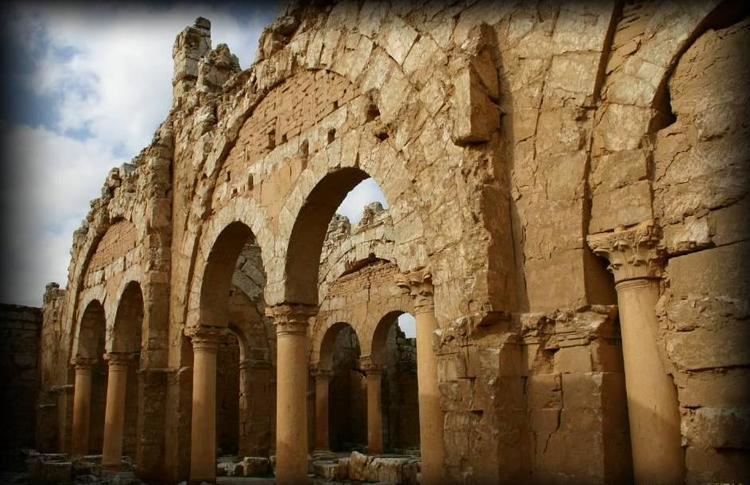Country Syria District Raqqa District Local time Tuesday 8:56 AM | Governorate Raqqa Governorate Elevation 300 m | |
 | ||
Occupation Islamic State of Iraq and the Levant Weather 14°C, Wind W at 19 km/h, 68% Humidity | ||
Resafa (Arabic: الرصافة [reṣafa]), known in Roman times as Sergiopolis (which has namesakes) and briefly as Anastasiopolis, was a city located in the Roman province of Euphratensis, in modern-day Syria. It is an archaeological site situated southwest of the city of Raqqa and the Euphrates.
Contents
Map of Resafa, Syria
Procopius describes at length the ramparts and buildings erected there by Justinian. The walls of Resafa, which are still well preserved, are over 1600 feet in length and about 1000 feet in width; round or square towers were erected about every hundred feet; there are also ruins of a church with three apses.
Names
Resafa corresponds to the Akkadian Raṣappa and the Biblical Rezeph (Septuagint; in Ancient greek Ràphes, Ράφες), where it is mentioned in Isaiah 37:12; cuneiform sources give Rasaappa, Rasappa, and Rasapi Herbermann, Charles, ed. (1913). "Sergiopolis". Catholic Encyclopedia. New York: Robert Appleton Company. .
Ptolemy calls it Rhesapha (Ρεσαφα in greek). In the late Roman Tabula Peutingeriana, it is called Risapa. In the Notitia dignitatum, it is Rosafa.
History
The site dates to the 9th century BC, when a military camp was built by the Assyrians. During Roman times, it was a desert outpost fortified to defend against the Sassanid Persians, and a station on the Strata Diocletiana. It flourished as its location on the caravan routes linking Aleppo, Dura Europos, and Palmyra was ideal. Resafa had no spring or running water, so it depended on large cisterns to capture the winter and spring rains.
Resafa was located in the area of the Roman–Persian wars, and was therefore a well-defended city that had massive walls that surrounded it without a break. It also had a fortress.
In the 4th century, it became a pilgrimage town for Christians coming to venerate Saint Sergius, a Christian Roman soldier said to have been martyred in Resafa during the Diocletianic Persecution. A church was built to mark his grave, and the city was renamed Sergiopolis. Indeed, it became the "most important pilgrimage center in Byzantine Oriens in [the] proto-Byzantine period", with a special appeal to the local Arabs, especially the Ghassanids.
In the 8th century, the Umayyad Caliph Hisham ibn Abd al-Malik (r. 724–743) made the city his favoured residence, and built several palaces around it.
Ecclesiastical history
Sebastopolis's first bishop was appointed shortly after 431 by John of Antioch, in spite of the opposition of the Metropolitan of Hierapolis Bambyce, on whom that church had till then depended. Later, Marianus attended a Council of Antioch.
The metropolis of Sergiopolis with five suffragan sees figures in the Notitia episcopatuum of Antioch in the sixth century. It had obtained this title from Emperor Anastasius I; at the fifth general council (Second Council of Constantinople) in 553, Abraham signed as Metropolitan. The favors of Ariastasius obtained for the city the name of Anastasiopolis, which it still retained at the beginning of the seventh century. Bishop Candidus, at the time of the Sassanian Persian siege of the city by Khosrau I (in 543), ransomed 1,200 captives for two hundred pounds of gold, and, in 1093, Metropolitan Simeon restored the great Basilica ("Echos d'Orient", III, 238); this proves that Christianity continued to exist even under Islam.
Titular see(s)
The (arch)diocese of Sergiopolis was nominally restored as a Roman Catholic titular bishopric, initially of the lowest (episcopal) rank, and under the curiate name Sergiopolis antea Resapha (having namesakes see Sergiopolis), and had the following incumbents as such:
In 1925, it was promoted to titular archbishopric of the highest, Metropolitan rank, and its name was shortened to Sergiopolis. As such, is has had the following incumbents, the first two however still only as titular bishop :
